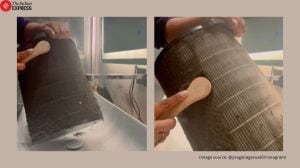Memories,Musings & Murder
She hated being admitted to boarding school at the age of five but it is that very experience that gave her inspiration for her novel.
Writing her first fiction novel transported US-based Nayana Currimbhoy back to her hostel days in Panchgani
She hated being admitted to boarding school at the age of five but it is that very experience that gave her inspiration for her novel. “I always knew I would write about my school days so when I was turning 50,I thought it’s now or never,” says writer Nayana Currimbhoy,who recently released her novel,Miss Timmins’ School for Girls . On Saturday,she read a few excerpts at Open Space,Law College Road.
Currimbhoy is based in the US and works with her architect husband for their firm in New York. But writing has always been a passion and freelance assignments for different publications have continued through the years. She has also written a biography on Indira Gandhi for children. ” Miss Timmins’ School for Girls is my first experiment with fiction writing,” she says.
Set in the 1970s amidst the beautiful locales of Panchgani,the novel is a murder mystery revolving around a young teacher from a conservative Maharashtrian Brahmin family. It is a blend of three cultures – the British nuns,the age of rock-and-roll and the hippie movement of the 1970s. Despite it being set 30 years back,Currimbhoy describes the novel as ‘coming of age’ and it has been selected for the Summer Reading List by Oprah Winfrey.
When I was in hostel,it was very weird to eat rice with forks and spoons,porridge for breakfast. We even danced the Scottish way,” she says. For her novel,she feels Panchgani was the perfect choice. “Back then,it was a sleepy hill-station with just two cars on the roads. A good setting for a murder mystery. I still remember the desolate pathways,” she adds. While writing her book,she didn’t visit the hill-station. “I did not want to disrupt my memories,” she says.
Currimbhoy wanted to write fiction because it helped her sail through problems in life. “I want people to dream in my book. Writing fiction was not really a challenge because I have always had the knack of concocting tales! Fiction has a slippery slope. The action of the story can go anywhere, she says. It was difficult finding time to write the book though. I would often go to the country side and lock myself in a small room to focus on the project, she says.







